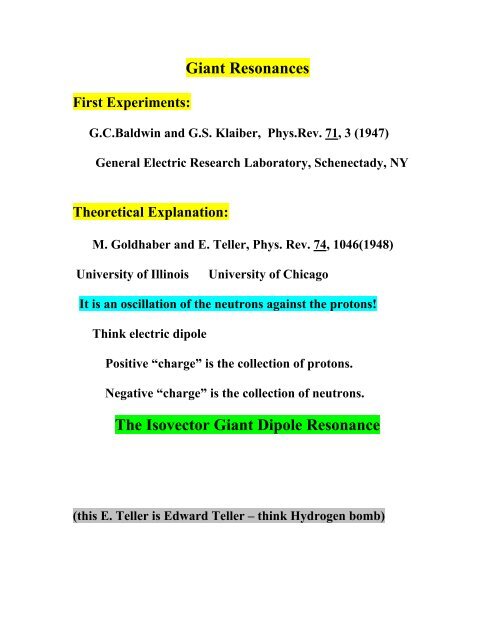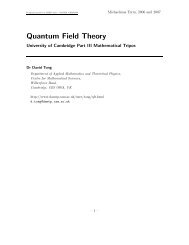Strength of Giant Resonances
Strength of Giant Resonances
Strength of Giant Resonances
Create successful ePaper yourself
Turn your PDF publications into a flip-book with our unique Google optimized e-Paper software.
<strong>Giant</strong> <strong>Resonances</strong>First Experiments:G.C.Baldwin and G.S. Klaiber, Phys.Rev. 71, 3 (1947)General Electric Research Laboratory, Schenectady, NYTheoretical Explanation:M. Goldhaber and E. Teller, Phys. Rev. 74, 1046(1948)University <strong>of</strong> IllinoisUniversity <strong>of</strong> ChicagoIt is an oscillation <strong>of</strong> the neutrons against the protons!Think electric dipolePositive “charge” is the collection <strong>of</strong> protons.Negative “charge” is the collection <strong>of</strong> neutrons.The Isovector <strong>Giant</strong> Dipole Resonance(this E. Teller is Edward Teller – think Hydrogen bomb)
40Ca20n20pIsovector <strong>Giant</strong> Dipole ResonanceAnalogous to charge distributionsMonopole L=0Dipole L=1Quadrupole L=2Octupole L=3Etc.There should be lots <strong>of</strong> “<strong>Giant</strong> <strong>Resonances</strong>”Isovector (n’s and p’s 180 o out <strong>of</strong> phase)Isoscalar (n’s and p’s in phase)Spin (spin up and down 180 o out <strong>of</strong> phase)
Shape Oscillations“<strong>Giant</strong> Resonance”1. Many Nucleons involved in motion (~ 10 in 40 Ca).2. Contains “most <strong>of</strong>” strength for that multipole.
Limit on strength for each multipole.Electromagnetic Operator Q L =∑ i r iLY LM (θ i )Y LM is a spherical harmonicfor multipole L, magnetic substate M.∑ n E n || 2 = S LEnergy Weighted Sum Ruleif there are no velocity dependent forces.E n is excitation energy <strong>of</strong> state|0> represents wave function <strong>of</strong> ground state“<strong>Giant</strong> Resonance”Contains ~90-99% <strong>of</strong> this strengthRest <strong>of</strong> strength in low lying states <strong>of</strong> nucleus.
1970: Only Dipole had been observed.Theorists: Came up with reasons why others weren’tthere!1971:Graduate Student: Ranier PitthanAdvisor: Thomas WalcherElectron scattering <strong>of</strong>f <strong>of</strong> Ce, La, Pr targetsDarmstadt, GermanyElectrons interact only with the protons(no nuclear force)Excite Isoscalar and Isovector states ~ same.
Texas A&M1973
One in particular:Isoscalar <strong>Giant</strong> Monopole ResonanceThe “breathing mode”A 3 dimensional harmonic oscillatorSHO: =(k/m) 1/2 and E= ħLiquid drop model <strong>of</strong> nucleus:E GMR =(ħ/3roA 1/3 )*(KA/m) 1/2ro is nuclear radiusA is #(protons + neutrons)m is mass <strong>of</strong> nucleonKA is compressibility <strong>of</strong> nucleusCan get compressibility <strong>of</strong> nucleus from ISGMRIF WE CAN FIND IT!
<strong>Strength</strong> <strong>of</strong> <strong>Giant</strong> <strong>Resonances</strong>Light Blue is what you see (the sum <strong>of</strong> strengths).Red is the Isoscalar <strong>Giant</strong> Monopole Resonance(what you want to measure)0.6<strong>Strength</strong>0.40.2<strong>Giant</strong> <strong>Resonances</strong>ISGMRLE ISGDRHE ISGDRISGQRHEORLEORIVGDRIVGQRTotal00 10 20 30 40E x (MeV)How do you separate out the Monopole??
Use an alpha particle beam to excite them!Alpha particle (2p, 2n): excites Isoscalar states strongly.Isovector states weakly.0.6<strong>Strength</strong>0.40.2<strong>Giant</strong> <strong>Resonances</strong>ISGMRLE ISGDRHE ISGDRISGQRHEORLEORIVGDRIVGQRTotal00 10 20 30 40E x (MeV)0.5Average Cross Section0.40.30.20.1Excite with AlphaParticles00 10 20 30E x (MeV)Need to do more!40
Distorted Wave Born ApproximationCalculationInelastic scattering E α =240MeV1000100d/d (mb/sr)101L=0L=1L=2L=3116 Sn(')E =240 MeV0.10 1 2 3 4 5 6 7 8 9 10 11 c.m. (deg)Measure at different scattering angles!Could separate Monopole from Quadrupoleby measuring 1.5 o to 4 o
Monopole Enhanced at 0 o .0.30 o Cross Section0.20.1Measure at 0 oThe Monopole!00 10 20 30 40Ex(MeV)0.34 o Cross Seciton0.20.1Measure at 4 oThe Quadrupole!00 10 20 30 40E x (MeV)
At Small anglesBeam would destroy detectors.Use Magnet to separate beam from inelastic scatteringBUT!Beam must be transported without hitting anything!Nobody had done 0 o inelastic scattering.
Measure over the minimum in the monopole.
later we succeeded at 0 o .oBUT average angle ~2 .
Built:New cyclotron - higher energy.New beam analysis/transport system - Clean beams.MDM spectrometer
Price List(September 2013)==================================================================================Production SwitchersSony, BRS 200 - HD/SD SDI(8 SDI Input / Multi-viewing / Chroma Engraving)ATEM Television Studio(4SDI Input / 4 HDMI Input / Multi-viewing / Chroma Engraving)Contact UsContact UsTapesSony, HDCAM Tape (6'-40'-64'-94'-124')Sony, Digital Betacam Tape (6'-12'-32'-64'-94'-124')Contact UsContact UsAudioSound Devices, 788T 8 Channel Recorder (with Mixing Console) $ 225Yamaha, Digital Audio Mixer O1V96 $ 125Sound Devices, 302 mixer $ 60Zoom H4n Handy Mobile 4-Track Recorder $ 60Fostex FR2 Field recorder $ 60Sennheiser, MKH-416 Shotgun $ 75Sennheiser, ew100 wireless neck microphone $ 50Sennheiser wireless system for handheld mic $ 50Sennheiser, ME-66 Shotgun $ 50Tram TR-50 Microphone $ 30Sony, ECM-674 Condenser microphone $ 25Electro Voice, Handheld microphone $ 15Shure, Beta 58 Handheld dynamic microphone $ 15Sennheiser, Headphone $ 1521 <strong>of</strong> 28
E GMR =ħ(K A /m) 1/2: mean square nuclear radiusm: nucleon massK A: compressibility <strong>of</strong> nucleusCompressibility <strong>of</strong> Nuclear MatterSimple Picture: Leptodermous ExpansionK A =K NM + K Surf A -1/3 +K vs ((N-Z)/A) 2 +K Coul *Z 2 /A 4/3K vs = K Sym + L(K’/K v -6)Where K NM : curvature <strong>of</strong> E/A around oK Sym : curvature <strong>of</strong> symmetry energyNote that E GMR depends on K NM AND K Sym !The Right Way to get K NMCalculate E GMR using effective interactions(each results in a specific K NM )Compare to experiment!Vretenar et al. PRC 68,024310(2003).Agrawal et al. PRC 68,031304(2003).Colò et al. PRC 70,024307(2004).Role <strong>of</strong> K v and K Sym in Infinite nuclear matter.
Microscopic Calculations:Non_Relativistic:Skyrme, Gogny effective interactions.Relativistic:NL1, NL3, etc. parameter sets.280Compare calculated to experimental EK nm obtained by comparing GMR energies and RPA calculations withGognyinteraction.GMR26024 Mg)40 Ca90 Zr144 SmKnm =231+-5 MeVKnm(MeV240208 Pb220116 Sn28 Si dhy et al. PRL82,691 (1999)dhy et al. PRC80,064318 (2009)2000 50 100 150 200250A24 Mg, 28 Si Péru,Goutte,Berger,NPA788, 44(2007)QuasiParticle RPA-HFB Gogny D1SK NM interaction dependent.Symmetry Energy dependence.Present: K NM ~ 220-240 MeV
Nuclear Matter Equation <strong>of</strong> StateA parametrization <strong>of</strong> the EOS to order 2 :(M. Farine et al. NPA 615,135(1997))E/A= A v +(K NM /18) 2 +[( n - p )/] 2 {J+(L/3) + (K Sym /18) 2 +..}+..Where =(- o )/ o and ( n - p )/ ~ (N-Z)/ASecond derivative leaves K NM and K SYM .K SYM goes as (N-Z)/A) 2
Present ResearchIncrease (N-Z/A) for K symMove away from stable nucleiD.H. YoungbloodY.-W.LuiJonathon Button(thesis project)Will McGrew (REU)Yi Xu (post doc joins 8/30/12)Hanyu Li (undergrad joins 9/1/12)Use unstable nuclei as beams:upgraded Cyclotron facility.Inverse reactions – Problem: Helium targetSolution: Use 6 Li targetX. Chen’s Thesis: 240 MeV 6 Li on 24 Mg, 28 Si, 116 Sn.Prove 6 Li scattering good for GMR.
Inelastic Scattering to <strong>Giant</strong> <strong>Resonances</strong>40006 116240 MeV Li + SnntsCou2000116 Sn avg =1.08 0 60 7000 10 20 30 40 50E x (MeV)d/d(mb/sr)1000100101116 Sn( 6 Li, 6 Li')E x =16.0MeVL=0L=1 T=0L=20 2 4 6 8(deg) cmL=3
Multipole Distributions116 SnFraction E0 EWSR/MeV0.30.20.16 LiE0Fraction E2 EWSR/MeV0.250.20.150.10.05E2005 15 25 35 5 15 25 35E x (MeV)E x (MeV)28 Si GMR0.1628 Si E0 EWSR/MeVFraction E0 EWSR/MeV0.120.080.046Li scatteringalpha scattering05 15 25E x (MeV)6 Li, agree for GR’s 116 Sn, 28 Si, 24 Mg.35
To study GMR in 27 Si6LiStops in targetto decay detector27Si6Li4.12sTarget27Si*10 -20 s23Mg11.32sto magneticspectrometer
Decay detector – Jonathan Button thesisWill McGrew: Analyzing dataTest runCalibrationDesigning Faraday Cup/Beam Stop
Other Monopole ThingsFraction E0 EWSR0.20.150.10.0590 Zr E016.9 MeV84%24.9 MeV22%Fraction E0 EWSR0.160.120.080.0492 M0 E016.6 MeV42%23.9 MeV65%05 10 15 20 25 30 35 40E x (MeV)0.1605 10 15 20 25 30 35 40E x (MeV)0.16Fraction E0 EWSR0.120.080.0492 Zr E016.5 MeV62%25.5 MeV38%Fraction E0 EWSR0.120.080.0496 M0 E016.2 MeV83%23.8 MeV20%05 10 15 20 25 30 35 40E x (MeV)05 10 15 20 25 30 35 40E x (MeV)0.16m1/m090 Zr 17.87 MeV92 M0 19.62 MeVFraction E0 EWSR0.120.080.04100 M0 E015.5 MeV97%23.6 MeV14%05 10 15 20 25 30 35 40E x (MeV)E GMR 92 Mo should be below 90 Zr??
KA(MeV)220200180160140K A for Mass 92 very different.K A from HF radiiZrMo12010088 90 92 94 96 98 100 102A92 MoK A 5 from expected value!
Nuclear equation <strong>of</strong> state influences many astrophysical processesDouble pulsar rotation (astro-ph 0506566)Binary mergers (astro-ph 0512126)Neutron star formation:Life <strong>of</strong> a type II supernovaProtonneutron star has aboutthe same density as nucleiStolen from :C. Hartnack and J. AichelinSubatech/University <strong>of</strong> NantesH. OeschlerTechnical University <strong>of</strong> Darmstadt
















